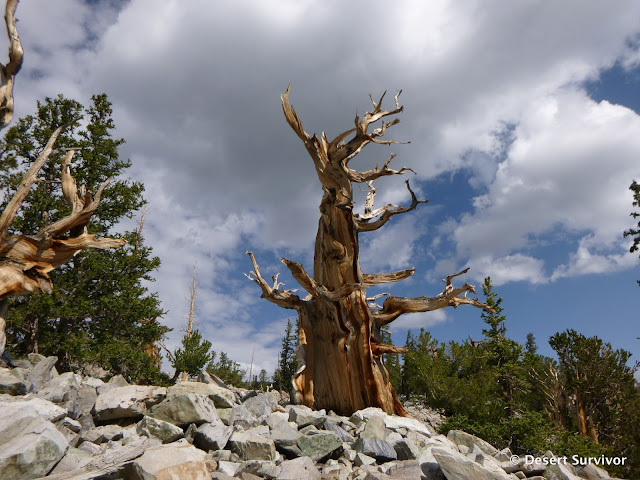After all those snack breaks, the kids were in a good mood and had their hiking groove on. We continued past the bristlecone grove to the Wheeler cirque glacier.
Soon we had a good view of the rock glacier. The actual glacier is at the headwall, covered with snow and falling rocks (we heard quite a few while we were up there). When I was in Alaska, I was taught that in order to be called a glacier, three conditions had to be met: 1. Ice 2. Moving 3. At least an acre in size. I've hiked up to the headwall previously and can verify that there is ice present (and it's quite slippery!). Being tucked against the north-facing wall has protected it from most of the sun's rays. Here's a view from October 2012:
A couple crevasses show that it is moving (ice cracks when it moves, and a crevasse is simply a fancy name for a crack in the ice).
The third condition, the size, is the one I'm not convinced is met. It's hard to tell because so much of the ice is covered with falling debris, so it's hard to determine what's ice and what's rock. According to Gerald Osborn and Ken Bevis in their 2001 article "Glaciation in the Great Basin of the Western United States," a glacier exists, so until a scientific article proves otherwise, I'm going with it. This makes this glacier the only one in Nevada. Who knew Nevada had a glacier?
I'm much more comfortable talking about the rock glacier, which is the bulk of what fills the cirque. A rock glacier is ice covered with rock, and the rock acts like an insulating blanket, protecting the remaining glacial ice from melting. Various studies have been done over the years, and one of the most recent looks promising to help explain if the rock glacier is active (moving). More on this in a future post (once the data has been verified and published).
You can find an excellent blog post written by a geologist friend with more info about the glacier and rock glacier here. Also, the glacier is covered in Chapter 5 of Great Basin National Park: A Guide to the Park and Surrounding Area
Desert Boy was happy to do a rock star pose for me. Desert Girl had a hard time deciding on her pose.
The flowers were great as we continued.
It's such a different looking world being in the cirque. On three sides are mountain walls over a thousand feet higher, and the steep cliff face of Wheeler Peak rises over 2,000 feet from the cirque. It's so barren looking, with so much grey rock. But the many flowers definitely brighten up the place for a month or two each summer.
We found a patch of snow and the kids had SO much fun playing in it.
The clouds floated by quickly, letting the sun peek through and illuminate various parts of the cirque.
Finally I made it to the sign that says "Rock Glacier Elevation 10,800 feet." The trail stops here, so if you want to go any further, you have to figure out your own route. Rocks fell every few minutes, with the crashing sounds echoing in the confined space. A raven flew nearby, squawking and sounding so much louder than at lower elevations.
The kids were excellent troopers. They had cooled off enough to put on an extra layer, and on the way down Desert Boy decided he was ready to carry his pack. We talked about moraines and how glaciers had pushed rocks around. He thought that was pretty cool.
He also wanted to check the GPS periodically. Desert Girl mainly wanted to climb and jump.
On the way back through the bristlecone grove we went slower to absorb the ancient trees. They weren't here when the glacier was at its maximum, but they've been growing here for thousands of years. Seeing a tiny strip of a tree alive (like the one above) makes us marvel at the adaptations life can make.
This was a very fun outing. We were not particularly fast, as the terrain is rough, and we started at about 10,000 feet in elevation. To the glacier and back was a bit over four miles. Desert Boy did it all, and Desert Girl did over three miles (and slept the fourth--she was plain tuckered out!). The trail is generally accessible on foot from June through mid-October. It's possible to ski or snowshoe here in the winter and spring, but it would be a long approach from the Upper Lehman Creek Campground, where the Wheeler Peak Scenic Drive closes in the winter. Nevertheless, someday I would love to see the rock glacier covered with thick snow, bringing thoughts of a colder, wetter time period in the Great Basin.
(This post includes an affiliate link; check out my disclosure policy here.)

































3 comments:
Very cool! You always give such good explanations of the area you are exploring. I never knew cirque had another use other than cirque du soleil :)
Lateral moraine and end moraine. Nice pictures.
What an awesome climate! The flowers growing with rocks in the background make for great pictures as well! It's nice to find someone else who enjoys writing and science too. :)
Post a Comment